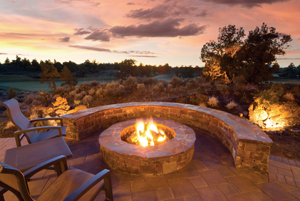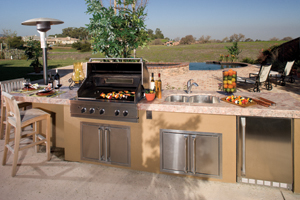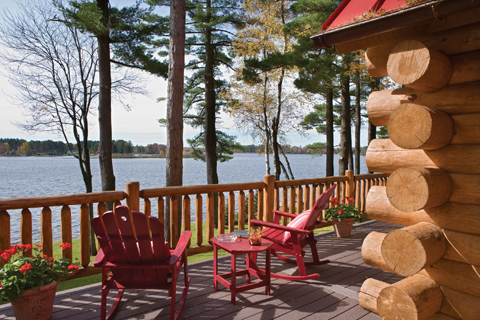Every year, magazines ranging from Cosmo to Consumer Reports give their lists of what’s “in” and what’s “out.” When it comes to housing, what’s in IS what’s out—outdoor living spaces, that is. As the square footage and footprints of homes continue to shrink in size (see Big Trend: Small Homes on page 16), people are finding innovative ways to maximize their living space, and the concept of the “outdoor room” is at the forefront of the movement. Log homes are no stranger to this trend. In fact, you could argue that the rest of the housing industry is finally catching up to what log home enthusiasts have known all along: that nature is a gift not to be taken for granted and that the only way to live is get out and enjoy it.
According to information published last year by the National Green Centre, outdoor living continues to increase in popularity. The results of an American Society of Landscape Architects (ASLA) survey of residential architects reveals that we should expect fewer frills this year as homeowners get back to the basics in a cool economy.
 “Homeowners want to create a sense of place for their family, friends, and neighbors to enjoy outside, but an uncertain economy means many will dial back some of the extra features we’ve seen in past years,” said ASLA executive vice president and CEO Nancy Somerville.
“Homeowners want to create a sense of place for their family, friends, and neighbors to enjoy outside, but an uncertain economy means many will dial back some of the extra features we’ve seen in past years,” said ASLA executive vice president and CEO Nancy Somerville.
For further evidence that outdoor living space is a shrewd investment as well as a source of enjoyment, in 2009, Kleber & Associates (kleberandassociates.com), a marketing and communications company to the home building industry, published an Outdoor Living white paper, analyzing the outdoor living phenomenon and looked at homeowners’ motivating factors. According to data accumulated from the American Institute of Architects, the National Home Builders Association, and independent focus groups and surveys, they found that 65 percent of new homebuyers will invest in outdoor living areas. Also, of those surveyed, 74 percent believed that having an outdoor living area increases the resale value of their home. The same percentage felt it was a good investment because it enhanced the overall environment of the home. About 51 percent thought having an outdoor living area would encourage them to entertain more often, while 37 percent believed it would mean that they’d spend less money on eating out and entertainment. Only 14 percent of participants considered an outdoor room to be a waste of money.
So what are some of the smartest, edgiest ideas for log cabin homes? Here are our top five essentials:
1. Layers. As you’re planning your outdoor room(s), incorporate layers, varying elevations, and twists and turns into your design. A simple step down from a low-level natural or simulated wood deck to a flagstone patio can create a sense of separation between “rooms,” just as a change of elevation or flooring can inside your home. A space should unfold slowly before you, enabling you to see something new from every angle.

3. Firepower. In our opinion, no outdoor entertaining destination is complete without the golden glow of a fire. Whether you have room in your budget for a simple fire pit or a soaring masonry hearth, a crackling flame is an outside essential. Chimineas are another alternative. Not only are they elegant and affordable, they’re portable, so you can move the fire as the spirit moves you.
4. Complete kitchens. Gone are the days of flipping burgers over a hibachi. Today’s outdoor kitchens combine the primal need to grill with all the bells and whistles that would make an Iron Chef flush with excitement. Pizza ovens, ice makers, wine fridges, warming drawers, granite countertops are all standard outside fare these days. Add sleek stainless steel cabinetry for a modern look that’s log cabin appropriate.
5. Storage. It’s not glamorous, but boy do you miss it if you don’t have it. You’ll need a convenient place outside to stash seat cushions, pillows, throws, fireplace equipment, gardening gear, and other supplies that bring the creature comforts of the indoors to the great outdoors.
Go Green
To keep your outdoor views lush and luxurious, you have to feed and nurture your plants and grass. Traditional sprinklers and watering systems waste water and energy. Opt for smarter, greener choices, such as a rain chain to channel rainwater from gutters into a barrel for potted plants and install an irrigation system with soil-moisture sensors so it only engages when it’s needed.

